Quench and Tempered Embrittlement of Ultra-High-Strength Steels with Transition Carbides
Abstract
:1. Introduction
2. Materials and Methods
3. Results
3.1. Dilatometry, DSC Analysis, Magnetic Saturation Measurements and Critical Temperatures
3.2. Microstructure
3.3. Distribution of Secondary Phase Particles
3.4. Mechanical Properties
3.5. Fractography
3.6. Cleavage Propagation in Martensite Lath Structure
4. Discussion
4.1. Carbon Redistribution in Lath Martensite Structure and Quench Embrittlement
4.2. Mechanism of Tempered Martensite Embrittlement
5. Conclusions
Author Contributions
Funding
Data Availability Statement
Acknowledgments
Conflicts of Interest
Abbreviations
| YS | yield stress |
| UHSS | ultra-high-strength steels |
| CVN | Charpy V-notch |
| RA | retained austenite |
| Q&P processing | quenching and partitioning processing |
| TME | tempered martensite embrittlement |
| PAG | prior austenite grains |
| σF | fracture stress |
| γs | surface energy of the cleavage plane |
| deff | effective grain size |
| Q&T | austenitizing followed by quenching and tempering treatment |
| SEM | scanning electron microscope |
| TEM | transmission electron microscope |
| EBSD | electron backscatter diffraction |
| LAB | low-angle boundary |
| HAB | high-angle boundary |
| DSC | differential scanning calorimetry |
| MS | martensite start temperature |
| MF | martensite finish temperature |
| Dpacket | average dimension of packets |
| DPAG | average dimension of PAGs |
| Np | number of packets in a PAG |
| dblock | average dimension of blocks |
| Nb | number of blocks in a packet |
| K–S | Kurdjumov–Sachs |
| OR | orientation relationship |
| ρKAM | densities of lattice dislocations were calculated from misorientation maps obtained by EBSD technique using Kernel average misorientation |
| AR | aspect ratio |
| UTS | ultimate tensile strength |
| PSE | product of strength and elongation |
| Elu | uniform elongation |
| Elt | total elongation |
| Pm | maximum load |
| DUTS | dynamic ultimate tensile strength |
| IZ | initiation zone |
| FCPZ | fast crack propagation/fibrous zone |
| SLZ | shear-lip zone |
| dCottrell | thickness of a Cottrell atmosphere |
| dlath | mean lath thickness |
| portion of carbon segregated in lath boundaries in the form of Cottrell atmospheres | |
| CSL | coincidence site lattice |
Appendix A. Structural Characteristics of the Fe-0.34C Steel

| Tempering Temperature, °C | Size of Nb(C,N), nm | Dimensions of η-Fe2C, nm | Size of Fe3C, nm |
|---|---|---|---|
| 20 | 27 | 40/5 | - |
| 200 | 33 | 73/6 * | - |
| 280 | 34 | 120/7 | - |
| 400 | 34 | 132/7 | - |
| 500 | 48 | - | 26 |
References
- Malakondaiah, G.; Srinivas, M.; Rao, P. Ultrahigh-strength low-alloy steels with enhanced fracture toughness. Prog. Mater. Sci. 1997, 42, 209–242. [Google Scholar] [CrossRef]
- Li, J.; Zhan, D.; Jiang, Z.; Zhang, H.; Yang, Y.; Zhang, Y. Progress on improving strength-toughness of ultra-high strength martensitic steels for aerospace applications: A review. J. Mater. Res. Technol. 2023, 23, 172–190. [Google Scholar] [CrossRef]
- Krauss, G. Steels: Processing Structure, and Performance, 2nd ed.; ASM International: Materials Park, OH, USA, 2005. [Google Scholar]
- Teramoto, S.; Imura, M.; Masuda, Y.; Ishida, T.; Ohnuma, M.; Neishi, Y.; Suzuki, T. Influence of Iron Carbide on Mechanical Properties in High Silicon-added Medium-carbon Martensitic Steels. Iron Steel Inst. Jpn. Int. 2020, 60, 182–189. [Google Scholar] [CrossRef] [Green Version]
- Tsuboi, M.; Shibata, A.; Terada, D.; Tsuji, N. Role of Different Kinds of Boundaries Against Cleavage Crack Propagation in Low-Temperature Embrittlement of Low-Carbon Martensitic Steel. Met. Mater. Trans. A 2017, 48, 3261–3268. [Google Scholar] [CrossRef]
- Zia-Ebrahimi, F.; Krauss, G. Mechanisms of tempered martensite embrittlement in medium-carbon steels. Acta Met. 1984, 32, 1767–1778. [Google Scholar] [CrossRef]
- Clarke, A.J.; Klemm-Toole, J.; Clarke, K.D.; Coughlin, D.R.; Pierce, D.T.; Euser, V.K.; Poplawsky, J.D.; Clausen, B.; Brown, D.; Almer, J.; et al. Perspectives on quenching and tempering 4340 steel. Metall. Mater. Trans. A 2020, 51, 4984–5005. [Google Scholar] [CrossRef]
- Tomita, Y. Development of fracture toughness of ultrahigh strength, medium carbon, low alloy steels for aerospace applications. Int. Mater. Rev. 2000, 45, 27–37. [Google Scholar] [CrossRef]
- Manokaran, M.; Kashinath, A.S.; Jha, J.S.; Toppo, S.P.; Singh, R.P. Influence of Tempering in Different Melting Routes on Toughness Behavior of AISI 4340 Steel. J. Mater. Eng. Perform. 2020, 29, 6748–6760. [Google Scholar] [CrossRef]
- Euser, V.K.; Williamson, D.L.; Clarke, A.J.; Speer, J.G. Cementite Precipitation in Conventionally and Rapidly Tempered 4340 Steel. JOM 2022, 74, 2386–2394. [Google Scholar] [CrossRef]
- Tikhe, O.; Doiphode, P.; Nichul, U.; Singh, R.; Hiwarkar, V. Development of Optimized Mechanical Properties of AISI 4340 Steel: Role of Quenching and Partitioning Process. Met. Mater. Int. 2023, 29, 2216–2227. [Google Scholar] [CrossRef]
- Nam, W.-J.; Choi, H.-C. Effects of silicon, nickel, and vanadium on impact toughness in spring steels. Mater. Sci. Technol. 1997, 13, 568–574. [Google Scholar] [CrossRef]
- Salvetr, P.; Gokhman, A.; Nový, Z.; Motyčka, P.; Kotous, J. Effect of 1.5 wt% Copper Addition and Various Contents of Silicon on Mechanical Properties of 1.7102 Medium Carbon Steel. Materials 2021, 14, 5244. [Google Scholar] [CrossRef]
- Euser, V.K.; Williamson, D.L.; Findley, K.O.; Clarke, A.J.; Speer, J.G. The Role of Retained Austenite in Tempered Martensite Embrittlement of 4340 and 300-M Steels Investigated through Rapid Tempering. Metals 2021, 11, 1349. [Google Scholar] [CrossRef]
- Salvetr, P.; Školáková, A.; Kotous, J.; Drahokoupil, J.; Melzer, D.; Jansa, Z.; Donik, Č.; Gokhman, A.; Nový, Z. Effect of Double-Step and Strain-Assisted Tempering on Properties of Medium-Carbon Steel. Materials 2023, 16, 2121. [Google Scholar] [CrossRef] [PubMed]
- Tkachev, E.; Borisov, S.; Borisova, Y.; Kniaziuk, T.; Gaidar, S.; Kaibyshev, R. Strength–Toughness of a Low-Alloy 0.25C Steel Treated by Q&P Processing. Materials 2023, 16, 3851. [Google Scholar] [CrossRef]
- Yuzbekova, D.; Dudko, V.; Pydrin, A.; Gaidar, S.; Mironov, S.; Kaibyshev, R. Effect of Tempforming on Strength and Toughness of Medium-Carbon Low-Alloy Steel. Materials 2023, 16, 1202. [Google Scholar] [CrossRef]
- Peters, J.; Bee, J.; Kolk, B.; Garrett, G. On the mechanisms of tempered martensite embrittlement. Acta Met. 1989, 37, 675–686. [Google Scholar] [CrossRef]
- Morsdorf, L.; Kashiwar, A.; Kübel, C.; Tasan, C. Carbon segregation and cementite precipitation at grain boundaries in quenched and tempered lath martensite. Mater. Sci. Eng. A 2023, 862, 144369. [Google Scholar] [CrossRef]
- Dudko, V.; Yuzbekova, D.; Gaidar, S.; Vetrova, S.; Kaibyshev, R. Tempering Behavior of Novel Low-Alloy High-Strength Steel. Metals 2022, 12, 2177. [Google Scholar] [CrossRef]
- Fedorova, I.; Kostka, A.; Tkachev, E.; Belyakov, A.; Kaibyshev, R. Tempering behavior of a low nitrogen boron-added 9%Cr steel. Mater. Sci. Eng. A 2016, 662, 443–455. [Google Scholar] [CrossRef] [Green Version]
- Kitahara, H.; Ueji, R.; Tsuji, N.; Minamino, Y. Crystallographic features of lath martensite in low-carbon steel. Acta Mater. 2006, 54, 1279–1288. [Google Scholar] [CrossRef]
- Euser, V.K.; Williamson, D.L.; Clarke, A.J.; Speer, J.G. Limiting Retained Austenite Decomposition in Quenched and Tempered Steels: Influences of Rapid Tempering and Silicon. Iron Steel Inst. Jpn. Int. 2020, 60, 2990–3000. [Google Scholar] [CrossRef]
- Bhadeshia, H.K.D.H. Physical Metallurgy of Steels. In Physical Metallurgy; Laughlin, D.E., Hono, K., Eds.; Elsevier: Amsterdam, The Netherlands, 2014; pp. 2157–2214. [Google Scholar] [CrossRef]
- Hanamura, T.; Yin, F.; Nagai, K. Ductile-Brittle Transition Temperature of Ultrafine Ferrite/Cementite Microstructure in a Low Carbon Steel Controlled by Effective Grain Size. Iron Steel Inst. Jpn. Int. 2004, 44, 610–617. [Google Scholar] [CrossRef]
- Inoue, T.; Qiu, H.; Ueji, R.; Kimura, Y. Ductile-to-Brittle Transition and Brittle Fracture Stress of Ultrafine-Grained Low-Carbon Steel. Materials 2021, 14, 1634. [Google Scholar] [CrossRef]
- Morris, J.J.W. On the Ductile-Brittle Transition in Lath Martensitic Steel. Iron Steel Inst. Jpn. Int. 2011, 51, 1569–1575. [Google Scholar] [CrossRef] [Green Version]
- Galindo-Nava, E.; Rivera-Díaz-Del-Castillo, P. A model for the microstructure behaviour and strength evolution in lath martensite. Acta Mater. 2015, 98, 81–93. [Google Scholar] [CrossRef] [Green Version]
- Tkachev, E.; Borisov, S.; Belyakov, A.; Kniaziuk, T.; Vagina, O.; Gaidar, S.; Kaibyshev, R. Effect of quenching and tempering on structure and mechanical properties of a low-alloy 0.25C steel. Mater. Sci. Eng. A 2023, 868, 144757. [Google Scholar] [CrossRef]
- Shibata, A.; Katsuno, T.; Tsuboi, M.; Tsuji, N. Effect of Bain unit size on low-temperature fracture toughness in medium-carbon martensitic and bainitic steels. Iron Steel Inst. Jpn. Int. 2023. [Google Scholar] [CrossRef]
- Javaheri, V.; Pallaspuro, S.; Sadeghpour, S.; Ghosh, S.; Sainio, J.; Latypova, R.; Kömi, J. Rapid tempering of a medium-carbon martensitic steel: In-depth exploration of the microstructure—Mechanical property evolution. Mater. Des. 2023, 231, 112059. [Google Scholar] [CrossRef]
- Calcagnotto, M.; Ponge, D.; Demir, E.; Raabe, D. Orientation gradients and geometrically necessary dislocations in ultrafine grained dual-phase steels studied by 2D and 3D EBSD. Mater. Sci. Eng. A 2010, 527, 2738–2746. [Google Scholar] [CrossRef]
- Niessen, F.; Nyyssönen, T.; Gazder, A.A.; Hielscher, R. Parent grain reconstruction from partially or fully transformed microstructures in MTEX. J. Appl. Crystallogr. 2022, 55, 180–194. [Google Scholar] [CrossRef]
- Miyamoto, G.; Iwata, N.; Takayama, N.; Furuhara, T. Mapping the parent austenite orientation reconstructed from the orientation of martensite by EBSD and its application to ausformed martensite. Acta Mater. 2010, 58, 6393–6403. [Google Scholar] [CrossRef]
- Mishnev, R.; Dudova, N.; Dudko, V.; Kaibyshev, R. Impact toughness of a 10% Cr steel with high boron and low nitrogen contents. Mater. Sci. Eng. A 2018, 730, 1–9. [Google Scholar] [CrossRef]
- Borisova, Y.; Mishnev, R.; Tkachev, E.; Kniaziuk, T.; Gaidar, S.; Kaibyshev, R. Structure, phase composition and mechanical prop-erties of high strength steel with transition h-Fe2C carbide. Physic Met. Metallogr. 2023; accepted for publication. [Google Scholar]
- Galindo-Nava, E.; Rainforth, W.; Rivera-Díaz-Del-Castillo, P. Predicting microstructure and strength of maraging steels: Elemental optimisation. Acta Mater. 2016, 117, 270–285. [Google Scholar] [CrossRef]
- Galindo-Nava, E. On the prediction of martensite formation in metals. Scr. Mater. 2017, 138, 6–11. [Google Scholar] [CrossRef] [Green Version]
- Shibata, A.; Miyamoto, G.; Morito, S.; Nakamura, A.; Moronaga, T.; Kitano, H.; Gutierrez-Urrutia, I.; Hara, T.; Tsuzaki, K. Substructure and crystallography of lath martensite in as-quenched interstitial-free steel and low-carbon steel. Acta Mater. 2023, 246, 118675. [Google Scholar] [CrossRef]
- Vervynckt, S.; Verbeken, K.; Lopez, B.; Jonas, J.J. Modern HSLA steels and role of non-recrystallisation temperature. Int. Mater. Rev. 2012, 57, 187–207. [Google Scholar] [CrossRef]
- Ning, D.; Dai, C.; Wu, J.; Wang, Y.; Jing, Y.; Sun, J. Carbide precipitation and coarsening kinetics in low carbon and low alloy steel during quenching and subsequently tempering. Mater. Charact. 2021, 176, 111111. [Google Scholar] [CrossRef]
- Porter, D.A.; Esterling, K.E.; Sherif, M. Phase Transformation in Metals and Alloys, 3rd ed.; CRS Press: Boca Raton, FL, USA, 2009; ISBN 978-1-4398-8357-0. [Google Scholar]
- Reguly, A.; Strohaecker, T.R.; Krauss, G.; Matlock, D.K. Quench embrittlement of hardened 5160 steel as a function of austenitizing temperature. Met. Mater. Trans. A 2004, 35, 153–162. [Google Scholar] [CrossRef]
- ASM International. A.S.M. Handbook: Mechanical Testing and Evaluation; ASM International: New York, NY, USA, 2000. [Google Scholar]
- Chaouadi, R.; Gérard, R. Development of a method for extracting fracture toughness from instrumented Charpy impact tests in the ductile and transition regimes. Theor. Appl. Fract. Mech. 2021, 115, 103080. [Google Scholar] [CrossRef]
- Mills, K.; Davis, J.R.; Destefani, J.D.; Dieterich, D. ASM Handbook. Fractography; ASM International: Materials Park, OH, USA, 1987; Volume 12. [Google Scholar]
- Dudko, V.; Fedoseeva, A.; Kaibyshev, R. Ductile-brittle transition in a 9% Cr heat-resistant steel. Mater. Sci. Eng. A 2016, 682, 73–84. [Google Scholar] [CrossRef]
- Mishnev, R.; Dudova, N.; Kaibyshev, R.; Belyakov, A. On the Fracture Behavior of a Creep Resistant 10% Cr Steel with High Boron and Low Nitrogen Contents at Low Temperatures. Materials 2020, 13, 3. [Google Scholar] [CrossRef] [Green Version]
- Wang, Q.; Ye, Q.; Wang, Z.; Kan, L.; Wang, H. Thickness Effect on Microstructure, Strength, and Toughness of a Quenched and Tempered 178 mm Thickness Steel Plate. Metals 2020, 10, 572. [Google Scholar] [CrossRef]
- Hutchinson, B.; Hagström, J.; Karlsson, O.; Lindell, D.; Tornberg, M.; Lindberg, F.; Thuvander, M. Microstructures and hardness of as-quenched martensites (0.1–0.5%C). Acta Mater. 2011, 59, 5845–5858. [Google Scholar] [CrossRef]
- Seehaus, M.; Korte-Kerzel, S.; Sandlöbes-Haut, S. Influence of Si on the microstructure and C redistribution in martensitic steels. Mater. Des. 2023, 229, 111875. [Google Scholar] [CrossRef]
- Raabe, D.; Herbig, M.; Sandlöbes, S.; Li, Y.; Tytko, D.; Kuzmina, M.; Ponge, D.; Choi, P.-P. Grain boundary segregation engineering in metallic alloys: A pathway to the design of interfaces. Curr. Opin. Solid State Mater. Sci. 2014, 18, 253–261. [Google Scholar] [CrossRef]
- Lejček, P.; Šob, M.; Paidar, V. Interfacial segregation and grain boundary embrittlement: An overview and critical assessment of experimental data and calculated results. Prog. Mater. Sci. 2017, 87, 83–139. [Google Scholar] [CrossRef]
- Wilde, J.; Cerezo, A.; Smith, G. Three-dimensional atomic-scale mapping of a cottrell atmosphere around a dislocation in iron. Scr. Mater. 2000, 43, 39–48. [Google Scholar] [CrossRef]
- Lejček, P.; Hofmann, S.; Paidar, V. The Significance of Entropy in Grain Boundary Segregation. Materials 2019, 12, 492. [Google Scholar] [CrossRef] [Green Version]
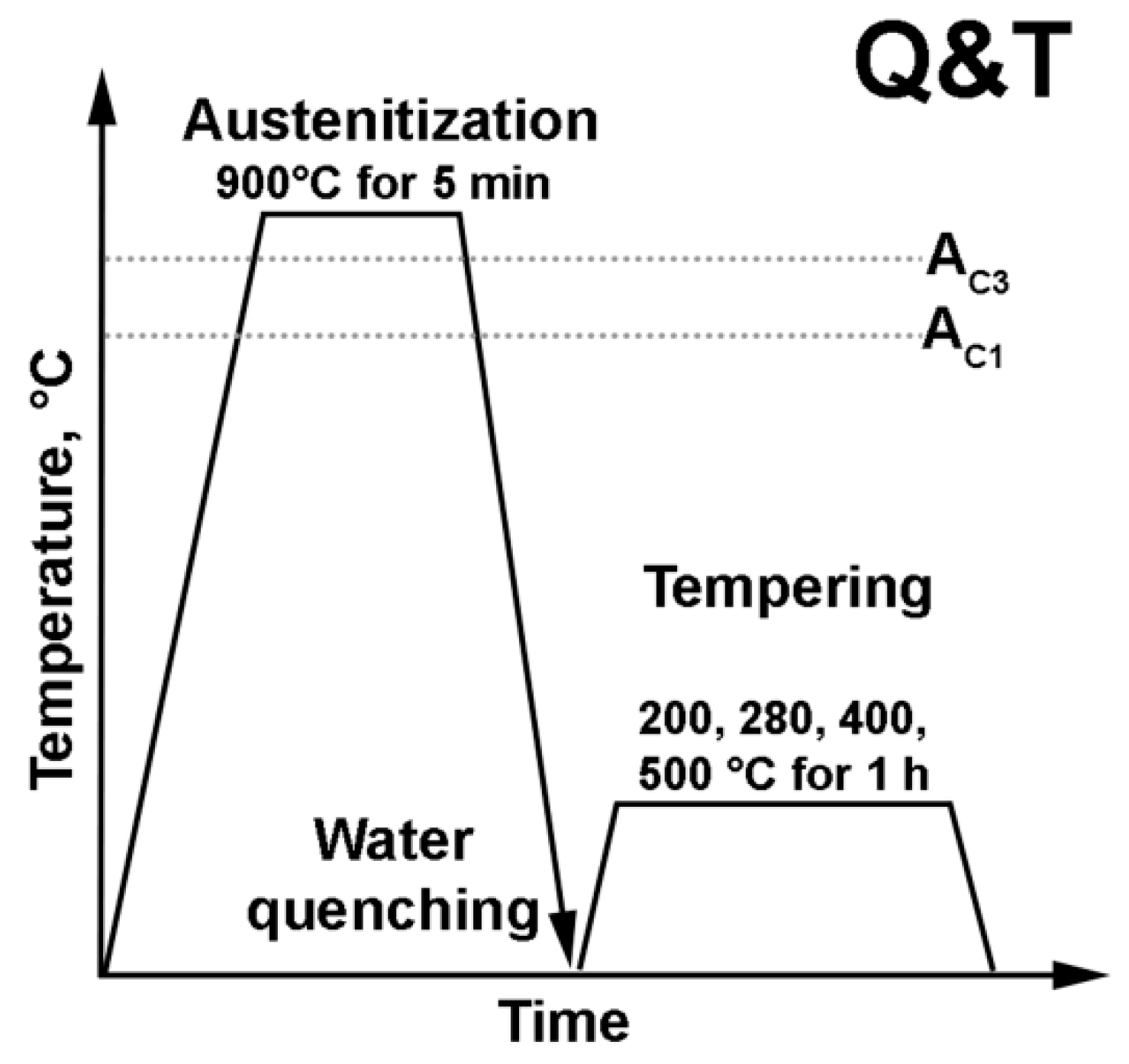
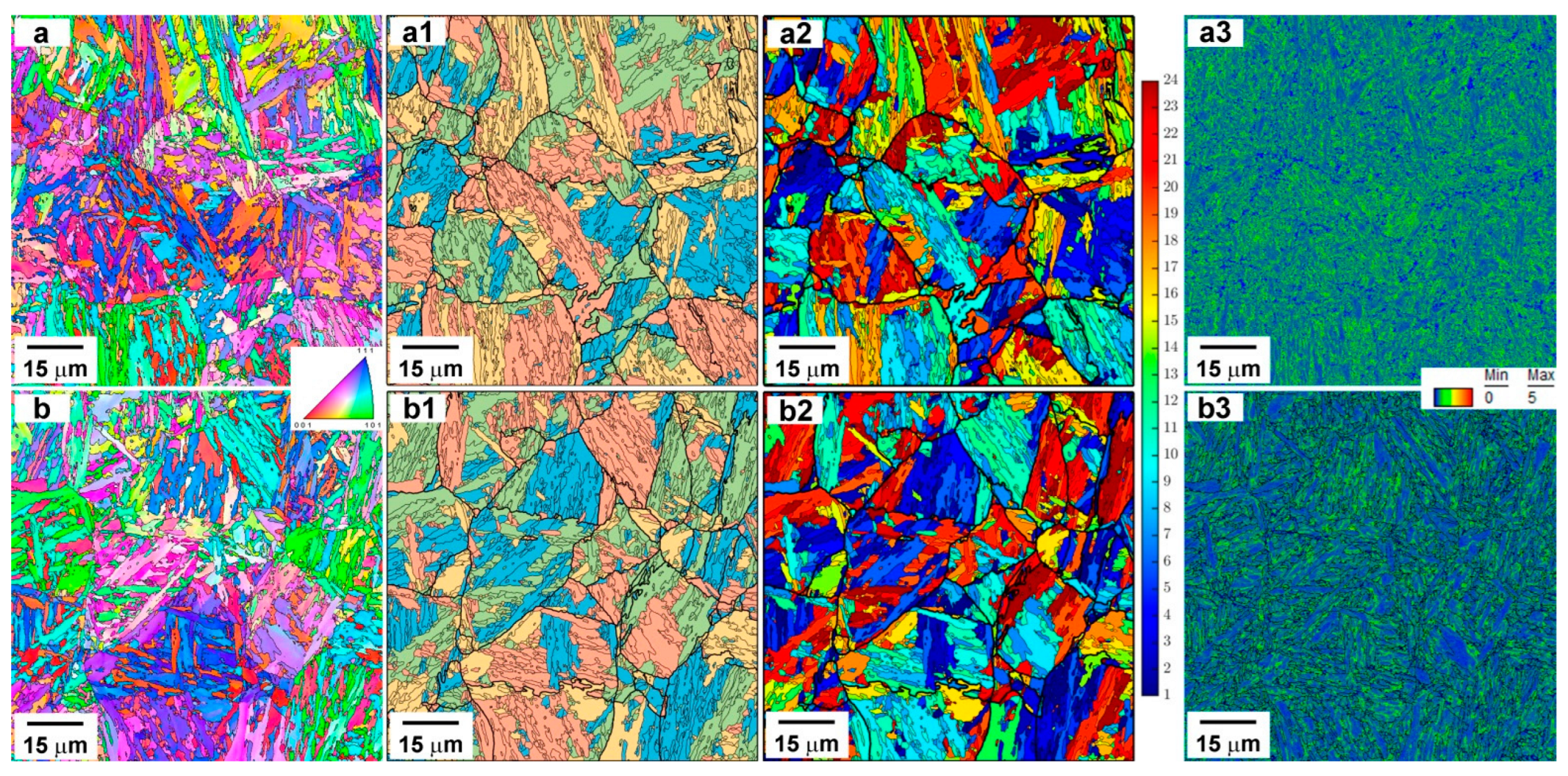
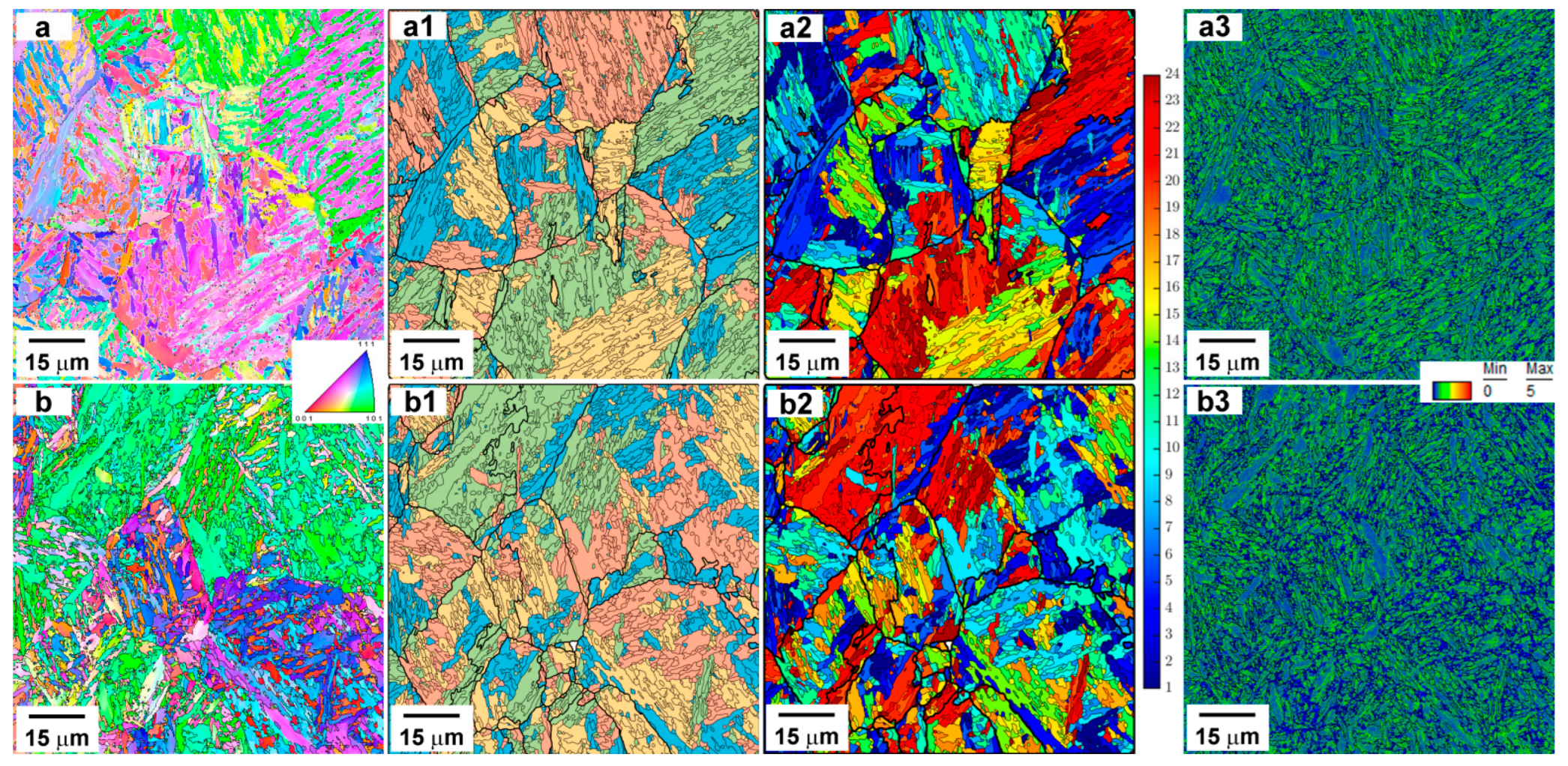

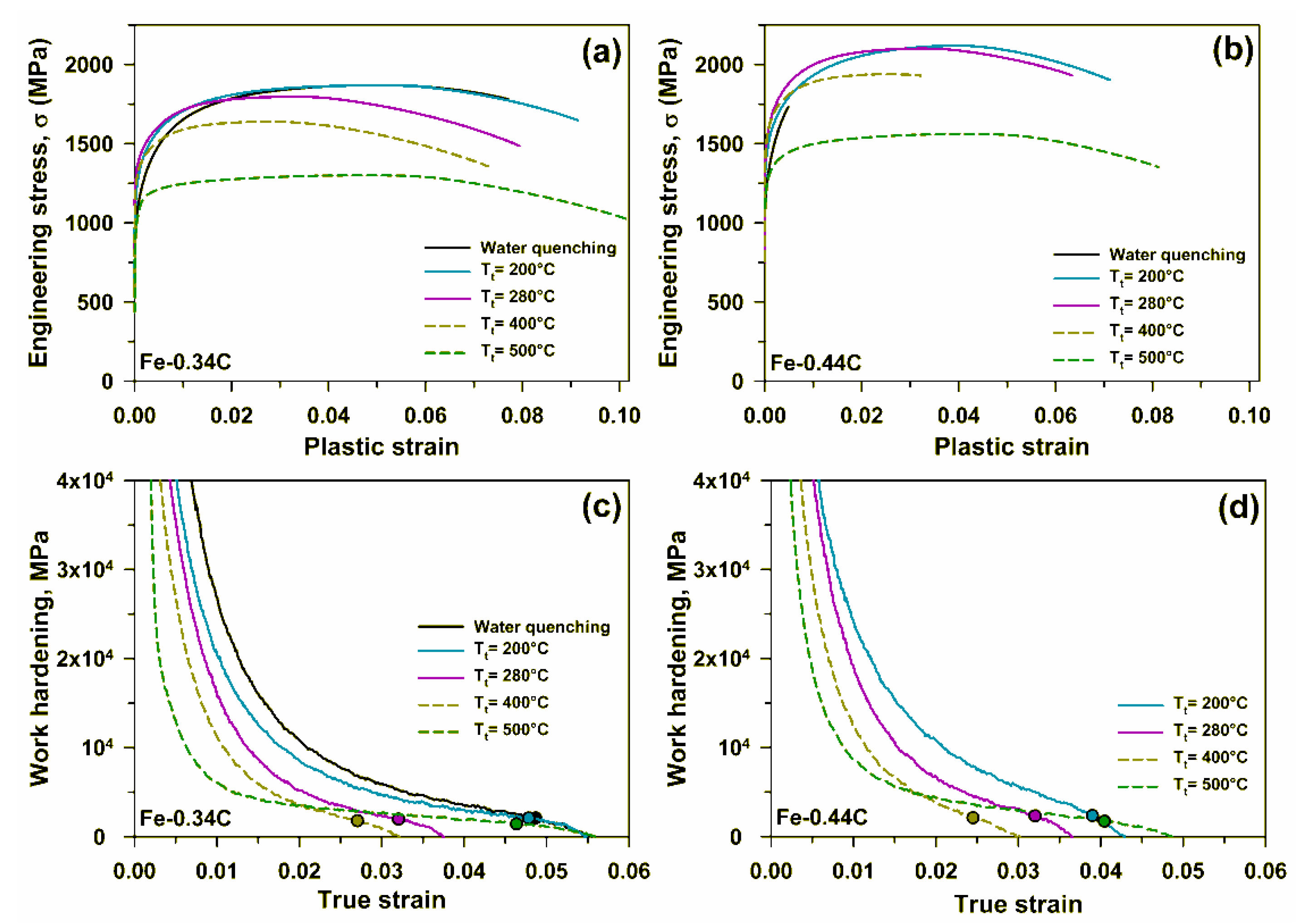
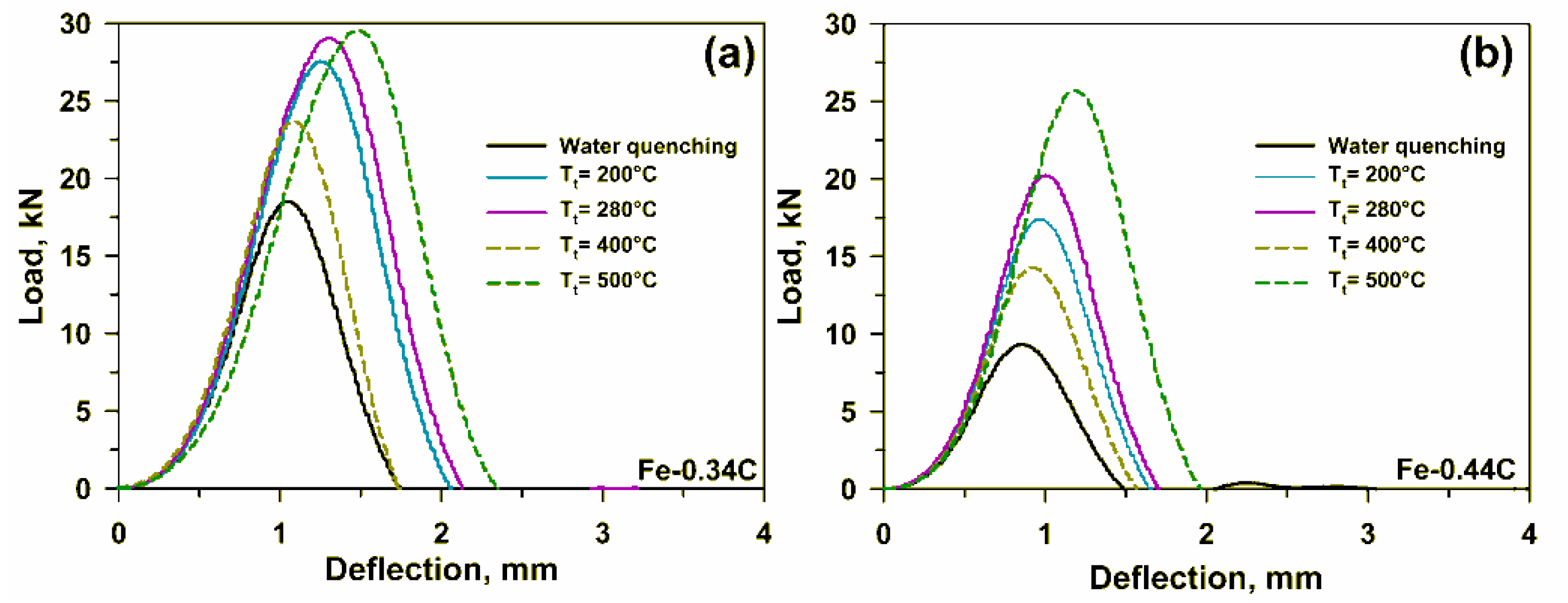
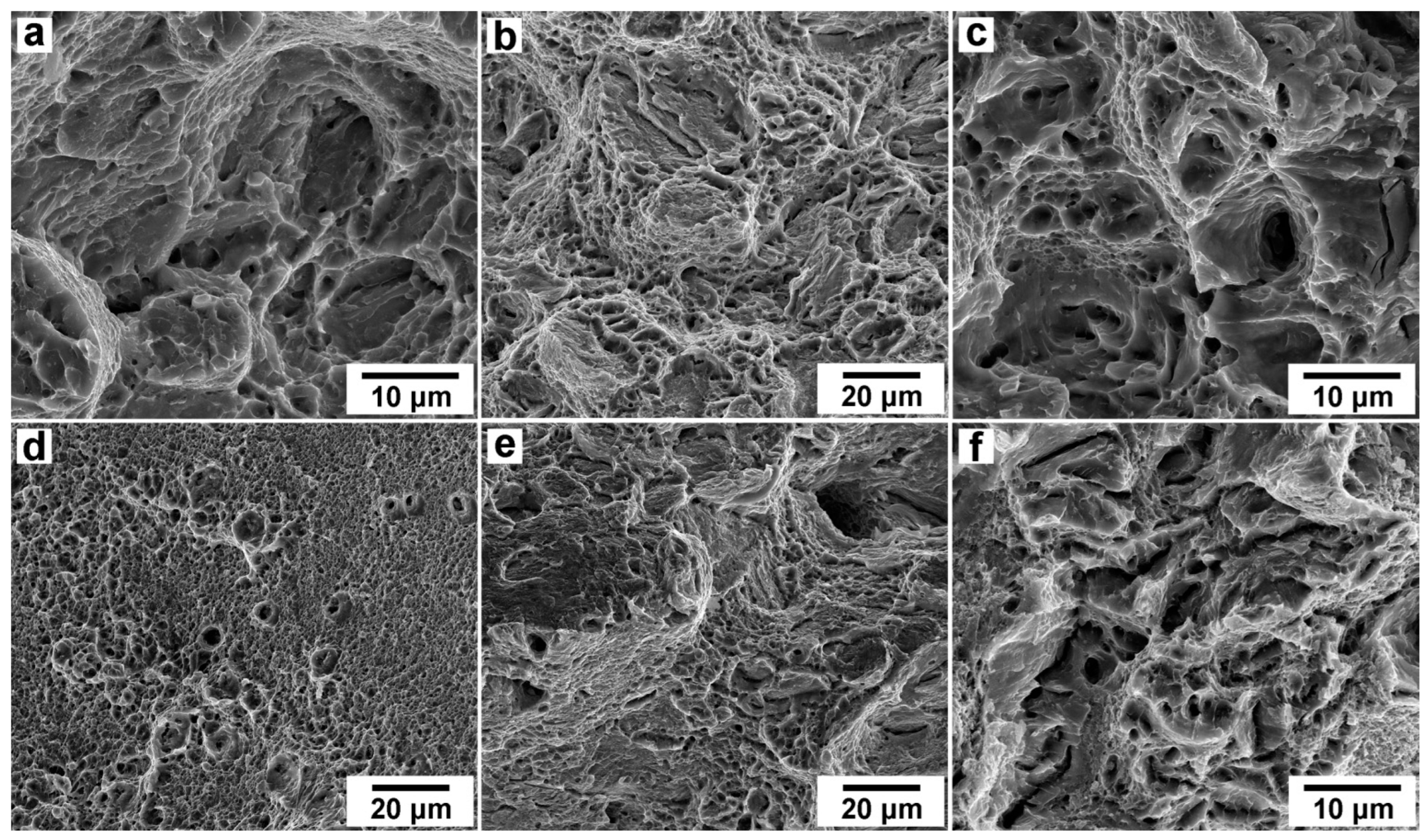
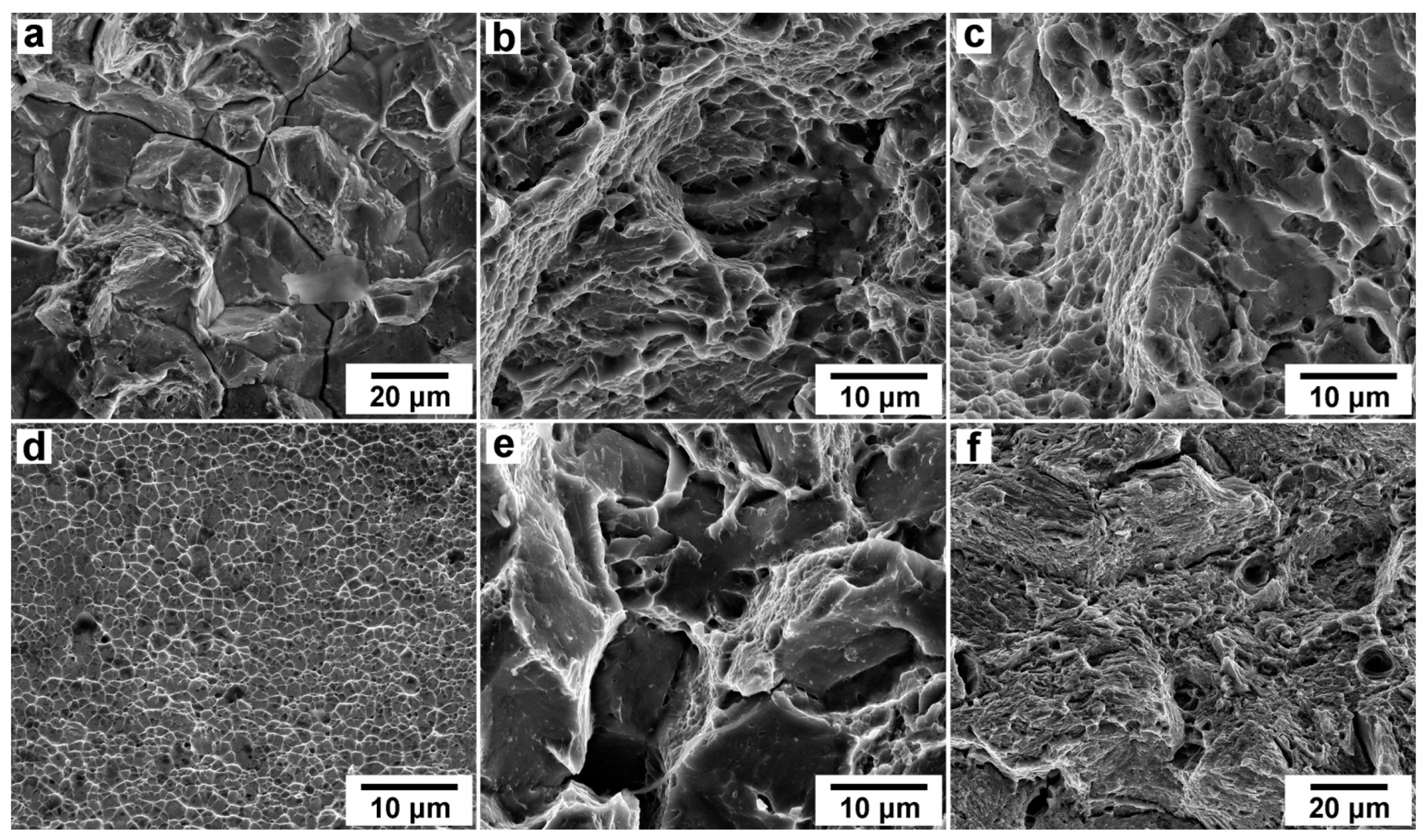

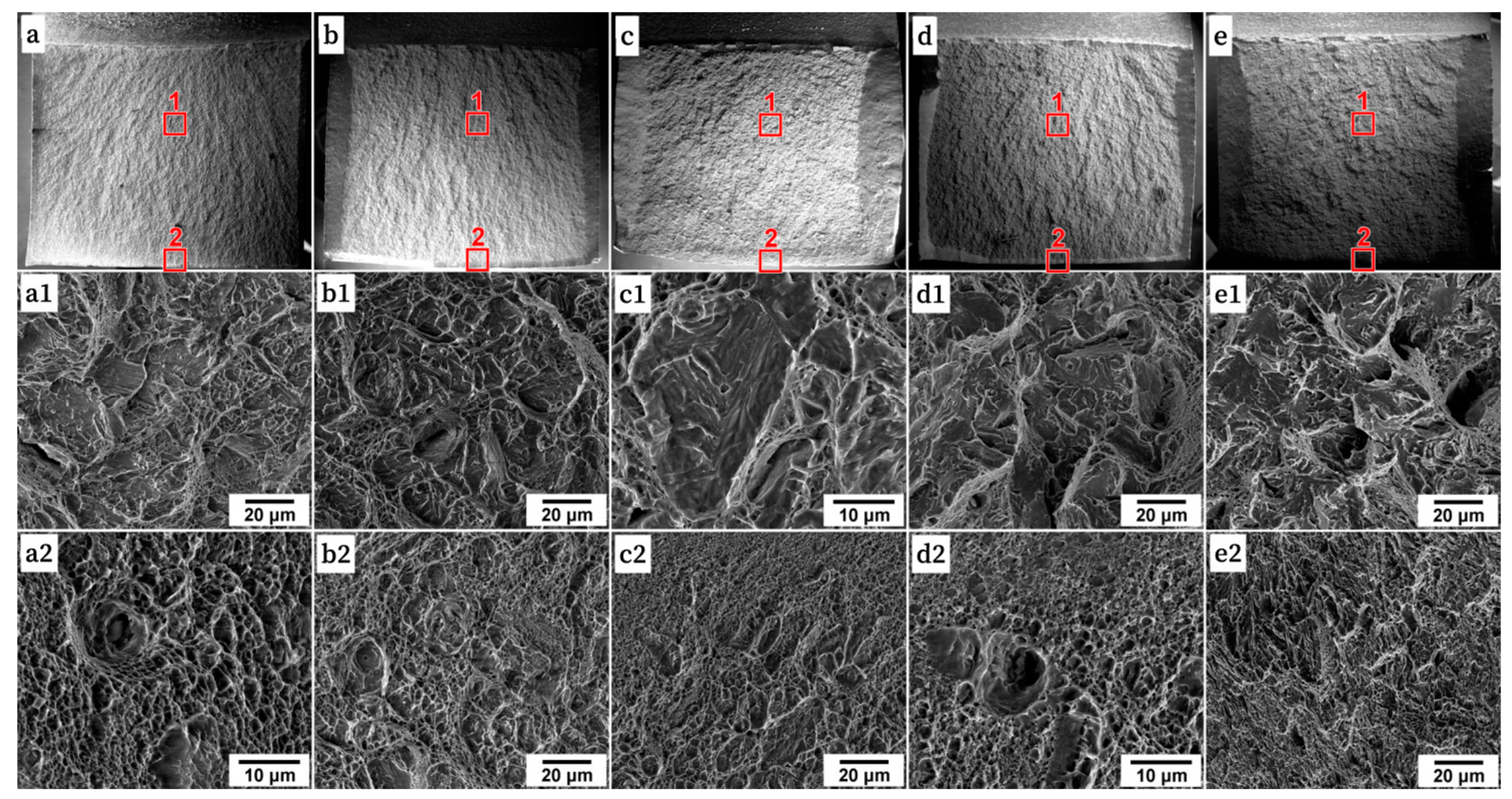

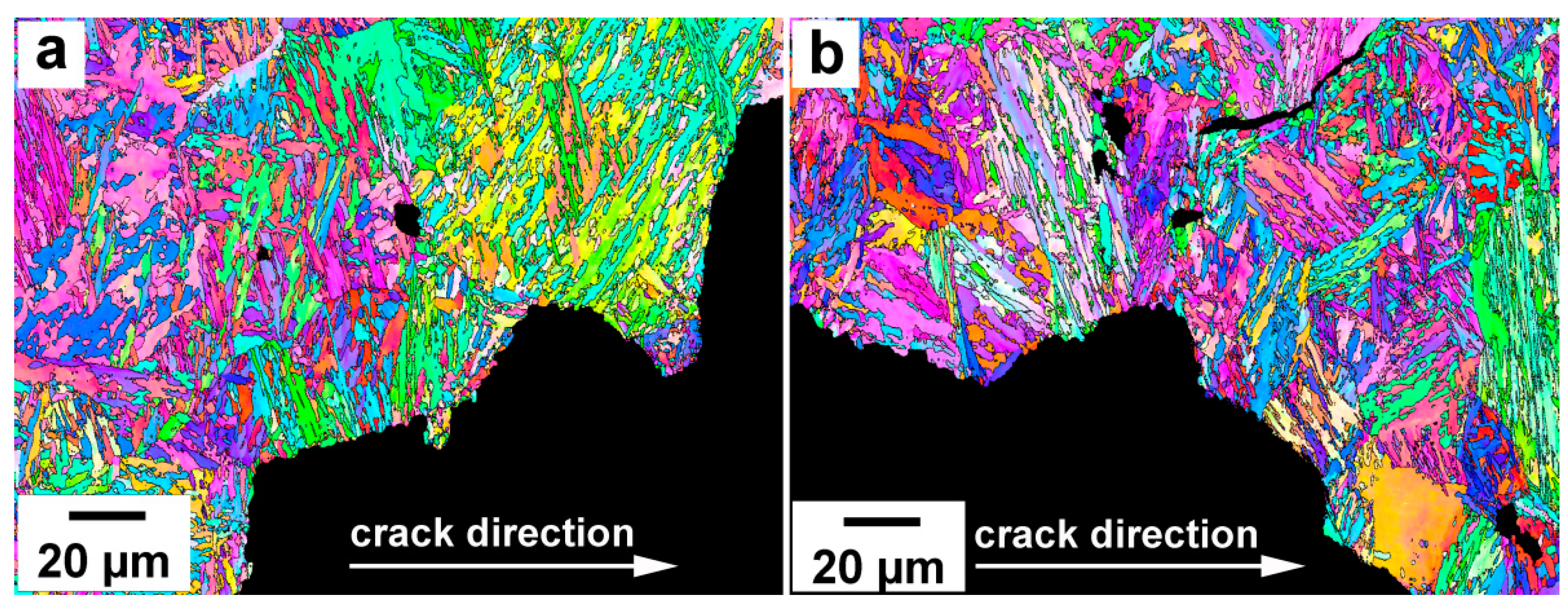
| Steel | C | Si | Mn | Cr | Mo | Nb | Ti | P | S |
|---|---|---|---|---|---|---|---|---|---|
| Fe-0.34C | 0.34 | 1.77 | 1.35 | 0.56 | 0.2 | 0.04 | 0.03 | 0.006 | 0.006 |
| Fe-0.44C | 0.44 | 1.81 | 1.33 | 0.82 | 0.28 | - | - | 0.007 | 0.001 |
| Steel | AC1, °C | AC3, °C | MS, °C | MF, °C |
|---|---|---|---|---|
| Fe-0.34C | 761 | 886 | 316 | 140 |
| Fe-0.44C | 766 | 857 | 270 | 51 |
| Tempering Temperature, °C | PAG Size, μm | Packet Size, μm | Block Thickness, μm | Distance between HABs, μm | Lath Thickness, nm | ρKAM ×1014, m−2 | Volume Fraction of RA, % |
|---|---|---|---|---|---|---|---|
| 20 | 23 ± 5 | 6.2 ± 1.5 | 0.53 ± 0.08 | 0.91 ± 0.13 | 209 ± 33 | 9.4 | 0.8 |
| 200 | 26 ± 4 | 8.5 ± 1.9 | 0.49 ± 0.08 | 0.98 ± 0.14 | 216 ± 34 | 9.1 | 0.6 |
| 280 | 27 ± 6 | 9.3 ± 2.1 | 0.65 ± 0.09 | 0.98 ± 0.14 | 234 ± 29 | 9.3 | 0.5 |
| 400 | 26 ± 6 | 8.6 ± 1.7 | 0.63 ± 0.07 | 1 ± 0.14 | 231 ± 35 | 8.4 | 0.4 |
| 500 | 23 ± 3 | 6.5 ± 1.2 | 0.52 ± 0.08 | 1 ± 0.14 | 235 ± 33 | 8.6 | 0.2 |
| Tempering Temperature, °C | PAG Size, μm | Packet Size, μm | Block Thickness, μm | Distance between HABs, μm | Lath Thickness, nm | ρKAM ×1014, m−2 | Volume Fraction of RA, % |
|---|---|---|---|---|---|---|---|
| 20 | 30 ± 5 | 11.5 ± 1.5 | 0.59 ± 0.15 | 0.86 ± 0.11 | 179 ± 29 | 9.5 | 3.9 ± 0.2 |
| 200 | 34 ± 3 | 10 ± 1.5 | 0.64 ± 0.12 | 0.9 ± 0.13 | 194 ± 30 | 7.8 | 2.8 ± 0.3 |
| 280 | 31 ± 5 | 8 ± 2 | 0.58 ± 0.12 | 0.7 ± 0.12 | 216 ± 32 | 8.5 | 1.1 ± 0.5 |
| 400 | 31 ± 4 | 7 ± 2 | 0.52 ± 0.19 | 0.72 ± 0.1 | 223 ± 29 | 8.7 | 0 |
| 500 | 35 ± 3 | 9.5 ± 1.5 | 0.65 ± 0.15 | 0.65 ± 0.15 | 243 ± 34 | 8.3 | 0 |
| Tempering Temperature, °C | Dimensions of η-Fe2C, nm | Size of Fe3C, nm |
|---|---|---|
| 20 | - | - |
| 200 | 41/3 * | - |
| 280 | 98/5 | - |
| 400 | 108/6 | - |
| 500 | - | 25 ± 3 |
| Tempering Temperature, °C | YS, MPa | UTS, MPa | Elu, % | Elt, % | PSE, GPa×% | HRC | CVN, J/cm2 |
|---|---|---|---|---|---|---|---|
| 20 | 1280 | 1870 | 4.3 | 7.5 | 14 | 54 | 17 |
| 200 | 1430 | 1870 | 4.4 | 9 | 17 | 54 | 31 |
| 280 | 1490 | 1870 | 2.9 | 8 | 14.4 | 53 | 35 |
| 400 | 1420 | 1640 | 2.3 | 7.5 | 12.3 | 50 | 23 |
| 500 | 1160 | 1300 | 4.6 | 10.5 | 14 | 43 | 38 |
| Tempering Temperature, °C | YS, MPa | UTS, MPa | Elu, % | Elt, % | PSE, GPa×% | HRC | CVN, J/cm2 |
|---|---|---|---|---|---|---|---|
| 20 | 1500 | 1730 | 0.5 | 0.5 | - | 60 | 6 |
| 200 | 1640 | 2120 | 3.9 | 7.5 | 15.5 | 58 | 12 |
| 280 | 1730 | 2100 | 3.1 | 6.5 | 13.6 | 57 | 14 |
| 400 | 1700 | 1940 | 2.5 | 3 | 6 | 55 | 9 |
| 500 | 1370 | 1560 | 3.7 | 8.5 | 13 | 47 | 20 |
| Tempering Temperature, °C | PM, kN | DUTS, MPa | ||
|---|---|---|---|---|
| Fe-0.34C | Fe-0.44C | Fe-0.34C | Fe-0.44C | |
| 20 | 18 | 9 | 711 | 356 |
| 200 | 28 | 17 | 1107 | 672 |
| 280 | 29 | 20 | 1147 | 790 |
| 400 | 23 | 14 | 909 | 553 |
| 500 | 29 | 25 | 1147 | 988 |
| Tempering Temperature, °C | IZ | FCPZ | SLZ | |||
|---|---|---|---|---|---|---|
| Fe-0.34C | Fe-0.44C | Fe-0.34C | Fe-0.44C | Fe-0.34C | Fe-0.44C | |
| 20 | 1 | 0.8 | 92 | 98 | 7 | 1.2 |
| 200 | 1.3 | 1.9 | 83 | 92 | 16 | 6 |
| 280 | 1.6 | 1.9 | 71 | 89 | 27 | 9 |
| 400 | 2.1 | 1.6 | 86 | 94 | 12 | 4.5 |
| 500 | 2.5 | 1.5 | 68 | 88 | 29 | 10 |
Disclaimer/Publisher’s Note: The statements, opinions and data contained in all publications are solely those of the individual author(s) and contributor(s) and not of MDPI and/or the editor(s). MDPI and/or the editor(s) disclaim responsibility for any injury to people or property resulting from any ideas, methods, instructions or products referred to in the content. |
© 2023 by the authors. Licensee MDPI, Basel, Switzerland. This article is an open access article distributed under the terms and conditions of the Creative Commons Attribution (CC BY) license (https://creativecommons.org/licenses/by/4.0/).
Share and Cite
Mishnev, R.; Borisova, Y.; Kniaziuk, T.; Gaidar, S.; Kaibyshev, R. Quench and Tempered Embrittlement of Ultra-High-Strength Steels with Transition Carbides. Metals 2023, 13, 1399. https://doi.org/10.3390/met13081399
Mishnev R, Borisova Y, Kniaziuk T, Gaidar S, Kaibyshev R. Quench and Tempered Embrittlement of Ultra-High-Strength Steels with Transition Carbides. Metals. 2023; 13(8):1399. https://doi.org/10.3390/met13081399
Chicago/Turabian StyleMishnev, Roman, Yuliya Borisova, Tatiana Kniaziuk, Sergey Gaidar, and Rustam Kaibyshev. 2023. "Quench and Tempered Embrittlement of Ultra-High-Strength Steels with Transition Carbides" Metals 13, no. 8: 1399. https://doi.org/10.3390/met13081399
APA StyleMishnev, R., Borisova, Y., Kniaziuk, T., Gaidar, S., & Kaibyshev, R. (2023). Quench and Tempered Embrittlement of Ultra-High-Strength Steels with Transition Carbides. Metals, 13(8), 1399. https://doi.org/10.3390/met13081399







